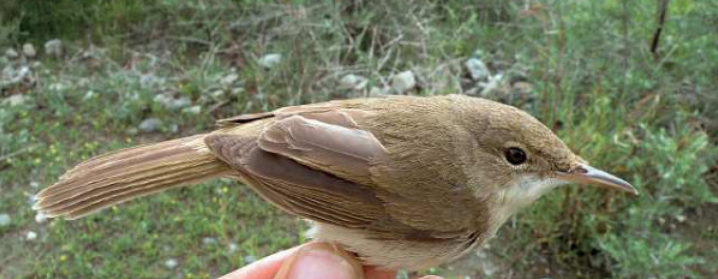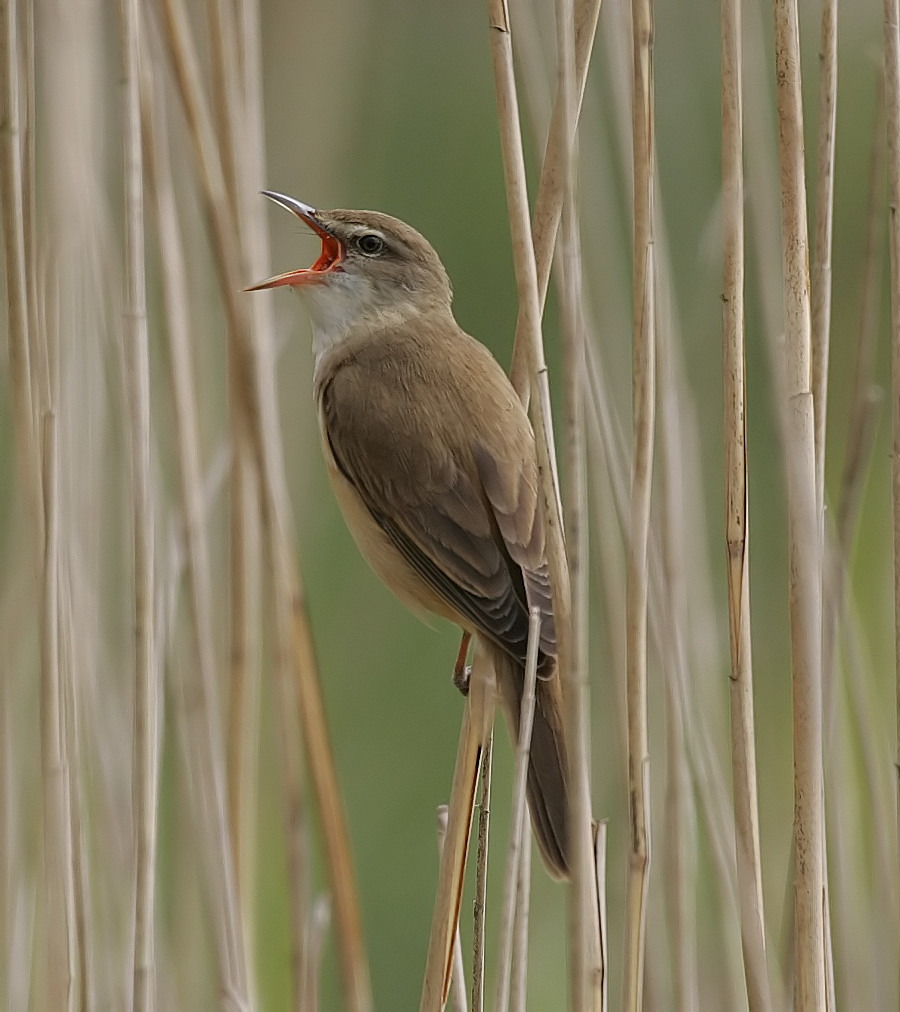Large-billed reed warbler
(→Sources) |
|||
| Line 16: | Line 16: | ||
[[Category: Fauna|W]] | [[Category: Fauna|W]] | ||
[[Category:Name|Alphabet]] | [[Category:Name|Alphabet]] | ||
| − | =Sources= | + | ==Sources== |
1) WCS Afghanistan's comprehensive note [http://afghanistan.wcs.org/Wildlife/LargeBilledReedWarbler.aspx] on the warbler | 1) WCS Afghanistan's comprehensive note [http://afghanistan.wcs.org/Wildlife/LargeBilledReedWarbler.aspx] on the warbler | ||
Revision as of 12:54, 30 November 2013
These are newspaper articles selected for the excellence of its content. |

Contents |
Sources
1) WCS Afghanistan's comprehensive note [1] on the warbler
2) Population of large-billed reed warbler, little-known bird, found in Afghanistan
[January 18, 2010 | http://latimesblogs.latimes.com/unleashed/2010/01/large-billed-reed-warbler-rare-bird-afghanistan.html LA Times Blogs]
3) ‘Extinct’ bird rediscovered in Afghanistan’s mountains By AP
The “world’s least known bird”?
Frequently referred to as the “world’s least known bird”, the large-billed reed warbler (Acrocephalus orinus) is a species that brought delight to conservationists working in Afghanistan and around the world in 2010 when it was reported to be thriving in north-eastern Afghanistan. U.K-based BirdLife International in 2007 called one of the world's rarest. The first specimen was discovered in India in 1867, with more than a century elapsing before a single bird was found in Thailand in 2006.
The first known breeding area of one of the world's rarest birds has been found in the remote and rugged Pamir Mountains in war-torn Afghanistan, a New York-based conservation group said.
A researcher with the New York-based Wildlife Conservation Society stumbled upon the tiny bird in 2008 and taped its distinctive song. Later, a research team caught and released 20 of the birds — the largest number ever recorded. On Sunday, Afghanistan’s National Environment Protection Agency added the large-billed reed warbler to its list of protected species.
Researchers are hoping the discovery sheds light on the bird
"Practically nothing is known about this species, so this discovery of the breeding area represents a flood of new information on the large-billed reed warbler," said Colin Poole, executive director of group's Asia Program. "This new knowledge of the bird also indicates that the Wakhan Corridor still holds biological secrets and is critically important for future conservation efforts in Afghanistan."
History
It was first collected in the Sutlej Valley of Himachal Pradesh in India back in 1867 and, since then, many have debated the bird’s authenticity as a separate species. After collections in north-eastern Afghanistan and Pakistan in the 1930s (that were never correctly identified as large-billed reed warblers), the next chapter in this species’ history was the trapping of a live individual in winter along the shores of the Inner Gulf of Thailand in 2006 and again in 2008.
These limited sightings together with specimens kept in museum collections suggested that the warblers migrated along the Himalayas to winter in northern India and other warmer parts of Southeast Asia, but actually bred in Central Asia. In 2008 WCS researchers in the Wakhan Corridor made an extraordinary discovery of the large-billed reed warbler, helping to validate it as a true species and also attain official protection status for it in Afghanistan, at least until more is discovered about its populations and biology.
The Wakhan Corridor of Afghanistan
The Wakhan Corridor in Afghanistan’s Badakhshan Province forms a stretch of land over 300 km long that reaches high up into the Pamirs in a unique area that borders Tajikistan, Pakistan and China. It is also flanked in the south by the Hindu Kush mountain range and contains areas of riverine habitat along the Wakhan and Pamir rivers.
The 2008 rediscovery
1 The bird was discovered in the Pamir Mountains, a sparsely populated region near China that has been relatively peaceful. It is, however, difficult to access -- part of the reason the breeding site is only now being discovered.
A researcher with the Wildlife Conservation Society stumbled upon the small, olive-brown large-billed reed warbler in 2008 and taped its distinctive song -- a recording experts now say is probably the first ever. He and colleagues later caught and released 20 of the birds, the largest number ever recorded, the group says. WCS is the only conservation group doing scientific studies in Afghanistan. It has been involved in helping set up the first national park, Band-e-Amir, in central Afghanistan, as well as working with the government to create the first-ever list of protected species.
At the time, however, Robert Timmins, who conducting a survey of aviary communities along the Wakhan and Pamir rivers, thought he was observing a more common warbler species.
But after a visit to a Natural History Museum in Tring in England to examine bird skins, Timmins realized he had something else on his hands.
Lars Svensson, a Swedish expert on the family of reed warblers and familiar with their songs, was the first to suggest that Timmins' tape was likely the first recording of the large-billed reed warbler.
2 During the summer of 2008, WCS researchers were conducting a survey along the Amu Darya river (where the Wakhan and Pamir rivers join) aimed at evaluating the status of breeding bird communities along the Corridor. WCS consultant Rob Timmins was walking through typical riparian habitat one early morning in mid-June and saw a lone reed warbler. On closer inspection of its distinctive morphological features and song, and after finding at least 12 other individuals, he suspected that this species was most likely the Blyth’s reed warbler (A. dumetorum). After the survey was complete, Rob visited the Natural History Museum in Tring to clarify his sightings and soon realized that what he saw that morning could well have been the elusive large-billed reed warbler. 3 Researchers returned to the site of Timmins' first survey in 2009, armed with mist nets used to catch birds for examination. The research team broadcast the recording of the song, which brought in large-billed reed warblers from all directions, allowing the team to catch 20 of them for examination and to collect feathers for DNA.
Lab work comparing museum specimens with measurements, field images, and DNA confirmed the find: the first-known breeding population of large-billed reed warblers.
"This is great news from a little-known species from a remote part of the world and suggests that there may be more discoveries to be made here," said Mike Evans, an expert on birds in the region for BirdLife. He did not take part in the discovery.
the announcement of the discovery of a home to the large-billed reed warbler came the same day Taliban militants launched an assault the Afghan capital, underscoring the challenges of doing conservation work in the country. 4 WCS Kabul mobilized immediately to try and find out more the following breeding season. Afghan researchers from WCS organized a mission to the Wakhan in the summer of 2009, and deployed mist nests all along the forested riverside habitat in Wakhan. Using playback from recordings, they successfully caught 15 warblers in these areas plus another four at a location further west from the original site.
After examining the photographs and biometrics, and obtaining DNA sequences, the identification of large-billed reed warblers in Afghanistan were finally confirmed, with the species also appearing to have a surprisingly high genetic diversity. Three very distinctive haplotype groups were found, suggesting that the warbler had undergone a period of separation in its subpopulations and that they had evolved independently. Seeing as these three groups now appear to exist together in a single locality, this indicates the separation has now collapsed, perhaps due to a shrinking range.
The ideal habitat
The riparian habitat in this area, with its dense scrubby bushland, provides ideal habitat and breeding conditions for the reed warbler along with a host of other passerine species such as the bluethroat (Luscinia sveccia), mountain chiffchaff (Phylloscopus sindianus) and Cetti’s bush warbler (Cettia cetti). It also acts as a perfect riverside corridor for a range of mammals including the common otter (Lutra lutra), cape hare (Lupus capensis), stone marten (Martes foina) and grey wolf (Canis lupus) and, with sea buckthorn thickets producing large clusters of orange berries every autumn, also provides a source of forage for migratory birds and the Himalayan brown bear (Ursus arctos).
The large-billed reed warbler’s discovery (or rather “rediscovery”) was very exciting for WCS and helped highlight the importance of the Afghan/Wakhan riverine habitats both as a probable breeding grounds for the species and as an entire ecosystem in itself, providing refuge for a range of floral and faunal species. Unfortunately, riverine habitats across Afghanistan and its northerly neighbor Tajikistan are under threat from extensive fuelwood collection, land conversion for agriculture and livestock grazing. WCS researchers have noted riverine habitats along the Amu Darya River in Tajikistan are now particularly impoverished and completely destroyed in places.
This is all the more alarming since the confirmation of a large-billed reed warbler breeding site in the Gorno-Badakhshan Autonomous Region of Tajikistan during July 2010. It is up to Tajikistan and Afghanistan to secure this species’ habitat as a matter of urgency, particularly since riverine scrublands form the reed warbler’s principle breeding habitat. Fortunately, passerines are not generally trapped or hunted by the local people in the Wakhan. Conservation measures put forward by WCS include the development of alternative sources of fuel for local communities and the halting of further agricultural expansion by improving the current cultivated areas.
In February 2010 however, boosted by the news of the bird’s exciting discovery by WCS, the Afghanistan Wildlife Executive Committee (AWEC) and the National Environmental Protection Agency (NEPA) took official steps to add the warbler to the country’s ever-growing list of Protected Species. The large-billed reed warbler is now protected by law in Afghanistan, helping to raise its profile significantly and encourage further study into its ecology and status, particularly as the species is currently listed on the IUCN’s red list as “data deficient.” With more information and data collected from Afghanistan, it will hopefully be possible to assign it a more accurate listing and develop strategies to aid its protection.
A preliminary paper on the finding appears in the most recent edition of BirdingASIA, the magazine of the Oriental Bird Club.
